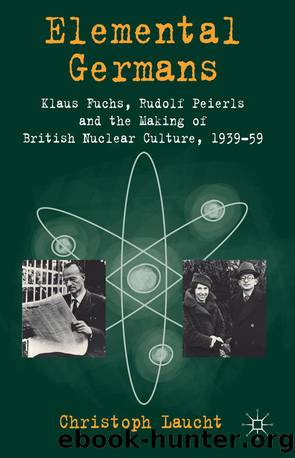Elemental Germans by Christoph Laucht

Author:Christoph Laucht
Language: eng
Format: epub
Publisher: Palgrave Macmillan
The international control of atomic energy
Besides creating a heightened public awareness of nuclear energy and educating Britons about it, the ideal of scientific ‘impartiality’ in political matters also governed the ASA’s second main objective – the international control of nuclear energy. Shortly after the war, Rudolf Peierls and many of his colleagues started to advocate this idea ‘to help in the solution of this most pressing problem’, as the ASA declared in its mission statement.139 The organization devoted considerable time and energy to discussing this issue.140 An article published in Nature in June 1946 reveals how significant many contemporaries deemed the idea of international control. ‘Until the individual nations are prepared to renounce national sovereignty to that limited extent’, the article concluded in a bleak tone on the current state of affairs, ‘atomic energy will continue to represent the great menace of our age, and its potentialities for good will remain an unsubstantial shadow’.141
During the final stages of the Manhattan Project, British atomic scientists had given first thoughts to this concept. In their ‘Memorandum from British Scientists at the Los Alamos Laboratory, New Mexico’, Rudolf Peierls and other members of the British team had already spoken out in favour of international control in the autumn of 1945.142 In a memorandum to Sir John Anderson, which built on the Los Alamos missive, Peierls had made further recommendations, especially on the imposition of a system of inspection as a means of achieving such a control scheme, as early as November 1945.143
The issuing of a statement on international control was one of the ASA Provisional Committee’s first chief tasks. Its members intended to submit a communiqué to the United Nations Atomic Energy Commission (UNAEC).144 Rudolf Peierls, Philip Moon and Marcus Oliphant drafted its first version before the Provisional Committee discussed and amended it.145 The large array of members from all areas of the political spectrum, and the release of the Acheson-Lilienthal Report, complicated its composition process considerably. Despite all varying views, ‘it was felt very strongly that the time had come when British atomic scientists should take some action along the lines similar to those taken by their American colleagues to try to ensure that enlightened politics are followed in connection with the control of atomic energy’, the ASA Joint Honourable Secretary put it, ‘so that this outstanding scientific achievement will not prove an unparalleled disaster to the human race’.146
Shortly after its formation as an independent organization, the ASA adopted an official line on the international control of atomic energy that closely followed the American Lilienthal-Acheson Plan and later the Baruch Plan as it was presented before the UN.147 Originally, US Secretary of War Henry Stimson and Undersecretary of State Dean Acheson had proposed a plan under which all future nuclear arms were to be placed under international control. In early 1946, Acheson was appointed as head of a committee in charge of drafting a plan on the international control of atomic energy to be presented before the AEC by Secretary of State James Byrnes.
Download
This site does not store any files on its server. We only index and link to content provided by other sites. Please contact the content providers to delete copyright contents if any and email us, we'll remove relevant links or contents immediately.
Fanny Burney by Claire Harman(25784)
Empire of the Sikhs by Patwant Singh(22173)
Out of India by Michael Foss(16312)
Leonardo da Vinci by Walter Isaacson(11903)
Small Great Things by Jodi Picoult(6096)
The Six Wives Of Henry VIII (WOMEN IN HISTORY) by Fraser Antonia(4791)
The Wind in My Hair by Masih Alinejad(4424)
The Lonely City by Olivia Laing(4121)
The Crown by Robert Lacey(4105)
A Higher Loyalty: Truth, Lies, and Leadership by James Comey(4033)
The Iron Duke by The Iron Duke(3639)
Millionaire: The Philanderer, Gambler, and Duelist Who Invented Modern Finance by Janet Gleeson(3569)
Sticky Fingers by Joe Hagan(3454)
Alive: The Story of the Andes Survivors by Piers Paul Read(3312)
Papillon (English) by Henri Charrière(3270)
Joan of Arc by Mary Gordon(3259)
Stalin by Stephen Kotkin(3086)
Aleister Crowley: The Biography by Tobias Churton(3021)
Ants Among Elephants by Sujatha Gidla(2925)
